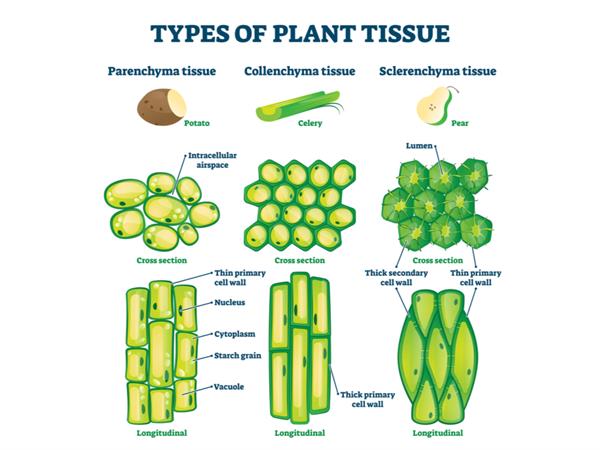PDF chapter test TRY NOW

Different types of simple permanent tissues
Differences between Parenchyma and Collenchyma
Characteristic features | Parenchyma | Collenchyma |
Cell wall | It is a living tissue contains a thin cell wall made up of cellulose. | It is a living tissue consists of a thick cell wall made up of cellulose, pectin, and hemicellulose. |
Arrangement of cells | Cells are loosely arranged with intercellular spaces, and their thickness isuniform. | The tissue consists of uneven well-developed thickenings at places adjacent to intercellular spaces. |
Function | It helps in the storage of food, nutrients and water. | Being a mechanical tissue gives flexibility and elasticity to the plant and prevents leaves' tearing. |
Location | It is present in the inner and outer parts of plant organs. | It is located mainly in the arial parts of the plant. It is restricted to sub epidermal parts of the plant. |
Differences between Collenchyma and Sclerenchyma
Characteristic features | Collenchyma | Sclerenchyma |
Nature of cells | Cells are living. | Cells aredead. |
Cells are made up of | Cells contains protoplasm (It has a central vacuole and peripheral cytoplasm with an elongated nucleus). | Cells areempty. |
Intercellular spaces and lumen | Intercellular spaces are absent, and the lumen of the cell is wide. | Intercellular spaces are absent, and the lumen of the cell is narrow. |
Thickening of cell wall | It consists of an uneven thickening cell wall is made up of cellulose. | It consists of a uniform thickening cell wall, which is lignified. |
Pits | Pits are simple straight, and unbranched. | Pits are simple oblique; sometimes, they are branched. |
Function | Being a mechanical tissue gives flexibility and elasticity to the plant and prevents leaves' tearing. | It helps to provide mechanical support to the plant. |
Difference between Sclereids and Fibres
Characteristic features | Sclereids | Fibres |
Shape of cells | They are short and broad irregular shaped branched/unbranched cells with blunt end walls. | They are elongated and narrow thread-like unbranched cells with tapering end walls. |
Arrangement of cells | Generally occur singly or in groups. | Generally occur in bundles. |
Pits | Pits are deep. | Pits are narrow. |
Function | It provides grittiness to fleshy fruits and stiffness and hardness to nuts and seed coat. | It provides strength and hardness. |
Origin | It is derived from a secondary wall thickening of parenchyma cells. | It is directly derived from the meristematic tissue. |
